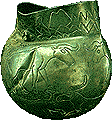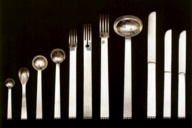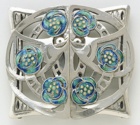
 silver -
A lustrous nearly white,
ductile, malleable
metallic element. Silver
reacts with hydrogen sulfide in air to form silver sulfide — tarnish. It is used for sculpture,
jewelry, tableware, and other
ornamentations, and is
widely used in mirrors, coinage,
photography, dental and soldering alloys,
electrical contacts, and printed circuits. Silver may be cast,
embossed, inlaid,
or worked as wire, sheet,
foil, or leaf.
Photographic emulsion
contain silver halides, because of their sensitivity
to light.
silver -
A lustrous nearly white,
ductile, malleable
metallic element. Silver
reacts with hydrogen sulfide in air to form silver sulfide — tarnish. It is used for sculpture,
jewelry, tableware, and other
ornamentations, and is
widely used in mirrors, coinage,
photography, dental and soldering alloys,
electrical contacts, and printed circuits. Silver may be cast,
embossed, inlaid,
or worked as wire, sheet,
foil, or leaf.
Photographic emulsion
contain silver halides, because of their sensitivity
to light.
Examples of works in silver:

Russia, North Caucasus, Maikop Burial Mound,
Vessel Decorated with Animals and a 'Landscape',
middle of the 3rd millennium
BCE,
silver, height 9.6 cm, Hermitage
Museum, St. Petersburg, Russia. See Russian
art and Stone
Age.

Egypt, Western Thebes, Scarab of Wah, c. 1990-85 BCE,
early Dynasty 12, Middle Kingdom, silver, gold, length
1 1/2 inches (3.8 cm), Metropolitan Museum of Art, NY. Much more
often carved from stone, scarabs
in silver are rare partly because silver ones deteriorated over
time.
Roman, Denarius,
Septimius Severus (Emperor CE
193-211), silver, collection of Michael Delahunt. See numismatics.
Roman, Graincourt-lès-Havrincourt, 3rd century CE, Plate, silver, diameter 35 cm, Louvre.

Sasanian Iran, Dish, Shapur II Hunting Lions, 4th century
v, silver, gilding, diameter
29.9 cm, Hermitage Museum, St. Petersburg, Russia.

Sasanian Iran, Head of a king, probably Shapur II, 4th
century CE,
silver, mercury gilding, height
15.8 inches (40 cm), Metropolitan Museum of Art, NY.

French, Bust of Louis XIV (1644-1712), silver
medal, Bibliotheque Nationale
de France, Paris. See Baroque,
engraving,
and portrait.

Cornelius Kierstede (American, 1675-1757,
New York, NY), Bowl, 1700-1710, silver, height
5 3/8 inches (13.7 cm), diameter
9 3/4 inches (24.8 cm), Metropolitan Museum of Art, NY.

Paul Revere (American, 1735-1818, Boston,
MA), Paine Service, 1773, silver, Worcester
Art Museum, MA. Paul Revere is also remembered for his heroism
during the American Revolutionary War.
.jpg)
Paul Revere, Hot Water Urn, 1791, silver, 22 x 10
3/4 inches (55.9 x 27.3 cm), Metropolitan Museum of Art, NY.
![]()

![]()
Paul Revere, Federal Style Tea Service, 1792-1793,
silver, Minneapolis Institute of Arts.

John Mortimer and John Samuel Hunt, makers
(English, in partnership 1839-1842), Caviar Pail, 1841, sterling
silver, Carnegie Museum of Art, Pittsburgh, PA. See helix.

Tiffany and Company (American, 1848-present,
New York, NY), Presentation Tray, 1884, silver, Minneapolis
Institute of Arts.

Tiffany and Company, The Magnolia Vase, c. 1893, silver, gold, enamel, opals, 31 inches x 18 inches (78.7
x 45.7 cm), Metropolitan Museum of Art, NY.

Tiffany and Company, Coffeepot, 1893, silver and enamel, height
10 inches (25.4 cm), Carnegie Museum of Art, Pittsburgh, PA.
See Art and ewer.

Josef Hoffmann (Austrian, 1870-1956) for Wiener Werkstätte, part of the Flat Model cutlery set, silver, c.1903-1904. See model and secession.

Eliel Saarinen (American, born Finland, 1873-1950),
designer, Manufacturer International Silver Company, Wilcox Silver
Plate Company Division (Meridan, Connecticut), Prototype Tea Service, c. 1933-35, electroplated nickel
silver, brass, and Bakelite;
Tea Urn, 1a-c: 14 1/2 x 7 3/4 inches (36.8 x 19.7 cm) Tray, 2:
diameter 17 1/2 inches
(44.5 cm) Creamer, 3: 3 x 6 x 3 7/8 inches (7.6 x 15.2 x 9.8
cm) Sugar Bowl, 4a,b: 6 3/4 x 6 x 3 7/8 inches (17.1 x 15.2 x
9.8 cm) Large Tray, 5: diameter
20 1/4 inches (51.4 cm), Metropolitan Museum of Art, NY. See
prototype.

Jessie M. King (English, 1875-1949) for Liberty & Company, Buckle, 1913, silver and enamel, 2 1/4 x 2 inches (5.71 x 5.08 cm), Los angeles County Museum of Art. See Arts and Crafts Movement.
Sterling silver is an alloy
containing 92.5% silver and 7.5% copper,
it is harder and more workable than pure silver. Symbol Ag; atomic
number 47; melting point 960.8°C; specific gravity 10.50;
valence 1, 2. A lustrous
light-to-medium gray color.
Also see basketry, crown, and numismatics.
https://inform.quest/_art